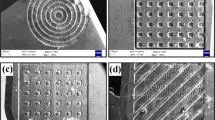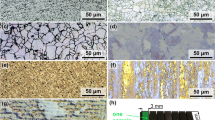Abstract
Die clearance is a widely known parameter affecting both tool life and edge quality of parts in blanking operations. Selecting the optimum punch–die clearance can give a longer tool life and better product quality by minimizing tool wear. In experimental studies, the effects of cutting die clearance and punch hardness on the punch edge and face wear were investigated. AISI D2 cold work steel with 50, 55 and 60 HRC-hardness punches was used as tool material. Three different cutting die clearances 3, 5 and 8% of sheet thickness were used. A modular punch–die set was prepared, and 2000, 4000, 6000 and 8000 samples are pressed. The results of the experiments showed that the punch edge and face wear decreased with increasing punch hardness and that smooth-sheared parts are strongly dependent on the clearance.
Similar content being viewed by others
References
Mucha, J.: An experimental analysis of effects of various material tool’s wear on burr during generator sheets blanking. Int. J. Adv. Manuf. Technol. 50, 495–507 (2010)
Luo, S.Y.: Studies on the wear conditions and the sheared edges in punching. Wear 208, 81–90 (1997)
Luo, S.Y.: Effect of the geometry and the surface treatment of punching tools on the tool life and wear conditions in the piercing of thick steel plate. J. Mater. Process. Technol. 88, 122–133 (1999)
Straffelini, G.; Bizzotto, G.; Zanon, V.: Improving the wear resistance of tools for stamping. Wear 269, 693–697 (2010)
Subramonian, S.; Altan, T.; Ciocirlan, B.; Campbell, C.: Optimum selection of variable punch-die clearance to improve tool life in blanking non-symmetric shapes. Int. J. Mach. Tools Manuf. 75, 63–71 (2013)
Soares, J.A.; Gipiela, M.L.; Lajarin, S.F.; Marcondes, P.V.P.: Study of the punch-die clearance influence on the sheared edge quality of thick sheets. Int. J. Adv. Manuf. Technol. 65, 451–457 (2013)
Achouri, M.; Germain, G.; Santo, P.D.; Saidane, D.: Experimental and numerical analysis of micromechanical damage in the punching process for high-strength low-alloy steels. Mater. Des. 56, 657–670 (2014)
Mori, K.; Maeno, T.; Fuzisaka, S.: Punching of ultra-high strength steel sheets using local resistance heating of shearing zone. J. Mater. Process. Technol. 212, 534–540 (2012)
Tekiner, Z.; Nalbant, M.; Gürün, H.: An experimental study for the effect of different clearances on burr, smooth-sheared and blanking force on aluminum sheet metal. Mater. Des. 27, 1134–1138 (2006)
Kwak, T.S.; Kim, Y.J.; Bae, W.B.: Finite element analysis on the effect of die clearance on shear planes in fine blanking. J. Mater. Process. Technol. 130–131, 462–468 (2002)
Hu, X.H.; Choi, K.S.; Sun, X.; Golovashchenko, S.F.: Edge fracture prediction of traditional and advanced trimming processes for AA6111-T4 sheets. J. Manuf. Sci. Eng. 136, 021016-11 (2014)
Myint, M.H.; Fuh, J.Y.H.; Wong, Y.S.; Lu, L.; Chen, Z.D.; Choy, C.M.: Evaluation of wear mechanisms of Y-TZP and tungsten carbide punches. J. Mater. Process. Technol. 140, 460–464 (2003)
Hernandez, J.J.; Franco, P.; Estrems, M.; Fuara, F.: Modelling and experimental analysis of the effects of tool wear on form errors in stainless steel blanking. J. Mater. Process. Technol. 180, 143–150 (2006)
Arslan, Y.; Özdemir, A.: Punch structure, punch wear and cut profiles of AISI 304 stainless steel sheet blanks manufactured using cryogenically treated AISI D3 tool steel punches. Int. J. Adv. Manuf. Technol. 87, 587–599 (2016)
Hambli, R.; Richir, S.; Crubleau, P.; Travel, B.: Prediction of optimum clearance in sheet metal blanking processes. Int. J. Adv. Manuf. Technol. 22, 20–25 (2003)
Maiti, S.K.; Ambekar, A.A.; Singh, U.P.; Date, P.P.; Narasimhan, K.: Assessment of influence of some process parameters on sheet metal blanking. J. Mater. Process. Technol. 102, 249–256 (2000)
Fang, G.; Zeng, P.; Lou, L.: Finite element simulation of the effect of clearance on the forming quality in the blanking process. J. Mater. Process. Technol. 122, 249–254 (2002)
Choi, H.S.; Kim, B.M.; Ko, D.C.: Effect of clearance and inclined angle on sheared edge and tool failure in trimming of DP980 sheet. J. Mech. Sci. Technol. 28(6), 2319–2328 (2014)
Faura, F.; Garcia, A.; Estrems, M.: Finite element analysis of optimum clearance in the blanking process. J. Mater. Process. Technol. 80–81, 121–125 (1998)
Hambli, R.; Potiron, A.; Kobi, A.: Application of design of experiment technique for metal blanking processes optimization. Mec. Ind. 4, 175–180 (2003)
Author information
Authors and Affiliations
Corresponding author
Rights and permissions
About this article
Cite this article
Akyürek, F., Yaman, K. & Tekiner, Z. An Experimental Work on Tool Wear Affected by Die Clearance and Punch Hardness. Arab J Sci Eng 42, 4683–4692 (2017). https://doi.org/10.1007/s13369-017-2621-0
Received:
Accepted:
Published:
Issue Date:
DOI: https://doi.org/10.1007/s13369-017-2621-0




